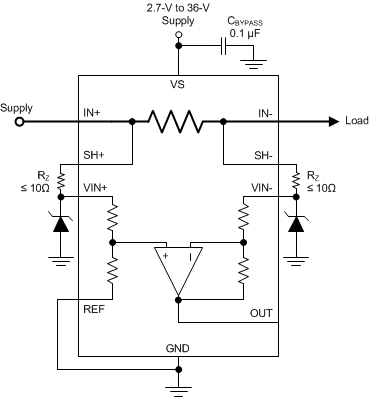ZHCSDO5C April 2015 – September 2023
PRODUCTION DATA
- 1
- 1 特性
- 2 应用
- 3 说明
- 4 Revision History
- 5 Pin Configuration and Functions
- 6 Specifications
- 7 Detailed Description
- 8 Applications and Implementation
- 9 Device and Documentation Support
- 10Mechanical, Packaging, and Orderable Information
7.4.4 Using the Device with Common-Mode Transients Above 36 V
With a small amount of additional circuitry, the
device can be used in circuits subject to transients higher than
36 V (such as in automotive applications). Use only
zener diodes or zener-type transient absorbers (sometimes referred to as
transzorbs); any other type of transient absorber has an unacceptable
time delay. Start by adding a pair of resistors, as shown in Figure 7-7, as a working impedance for the zener. Keeping these resistors as small as
possible is preferable, most often approximately 10 Ω. This value limits the affect
on accuracy with the addition of these external components, as described in the
Input Filtering section. Device interconnections between the shunt resistor and amplifier
have a current handling limit of 1 A. Using a 10-Ω resistor limits the allowable
transient range to 10 V above the zener clamp in order to not damage the device.
Larger resistor values can be used in this protection circuit to accommodate a
larger transient voltage range, resulting in a larger affect on gain error. Because
this circuit limits only short-term transients, many applications are satisfied with
a 10-Ω resistor along with conventional zener diodes of the lowest power rating
available.
 Figure 7-7 Device Transient Protection
Figure 7-7 Device Transient Protection